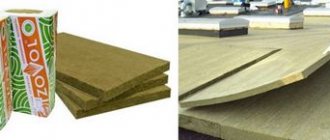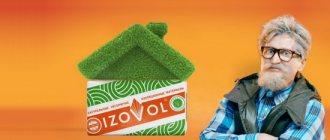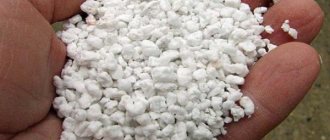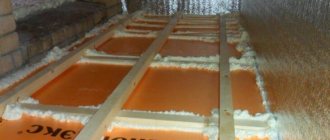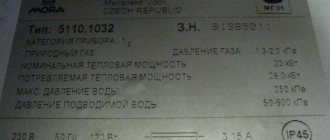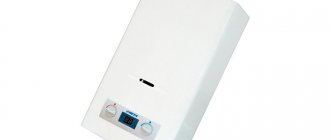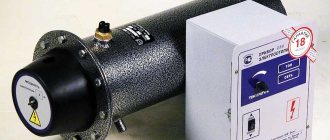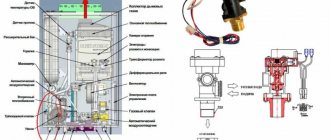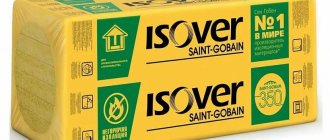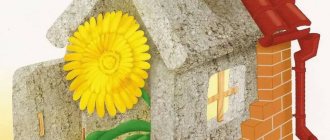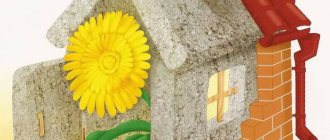Advantages of insulation
Mineral wool would not have become so popular among consumers if it did not have a number of advantages. In relation to Izobel brand insulation, the qualities listed below are considered as such.
- Excellent thermal conductivity - coefficient from 0.03 to 0.04 - one of the smallest among insulation materials. If we add to this the thinness and elasticity of basalt fibers, we get an almost ideal material that allows us to significantly save on heating the room.
- Fire resistance - isobel belongs to group IV of fire safety materials. If there is a fire source nearby, its physical and chemical properties will remain unchanged; the slabs will also become a barrier to the spreading fire.
- Long service life - insulation made from basalt stone lasts at least 50 years if storage conditions are met. Excess liquid will not affect the material in any way - the fibrous structure will easily allow steam to pass through and condensate to evaporate.
- Weak water absorption - basalt is non-hygroscopic; only 1.5% of its volume can be filled with moisture. If water-repellent additives are used in production, the value is reduced to 1%.
- Good vapor permeability - achieved by the fibrous structure of the material and promotes the use of isobel in baths, saunas or industrial premises.
- Sound insulation - depending on the thickness of the slab, they completely or partially neutralize extraneous noise.
- Resistant to corrosion, fungi, rodents, unattractive to birds.
- Affordable price - isobel costs on average 15% cheaper than mineral wool analogues; for a slab of 1 sq. m and a thickness of 50 mm, the consumer will pay from 100 to 300 rubles.
- Environmental safety - achieved by a minimum amount of chemical components used to increase water repellency, and this is not always the case.
The above is only part of the positive aspects of izobel insulation. Other benefits are easier to feel during operation rather than described.
Features of insulation
The area of use of isobel is reducing the thermal conductivity of buildings for various purposes. In the production of insulation, EcoSafe technology is used, which reduces the amount of moisture absorbed by the material. Izobel slabs are a type of basalt wool (material with the lowest thermal conductivity coefficient) and are manufactured without the use of blast furnace slag. Usually the insulation has a standard size (1000×600 mm, 1000×1000 mm, etc.).
Isobel can be produced not only from heavy basalt rocks, but also from lighter ones such as limestone or quartzite.
The resulting slabs weigh less and do not hold heat as well, but their density is higher, which affects durability. Similar izobel is used for cladding areas of the house where thermal insulation does not play a special role, but fire resistance and noise absorption are much more important (non-residential attics, ceilings, pitched roofs).
Features of isobel installation
Due to its ease of use, insulation is used almost everywhere. Thermal insulation with its help will be justified in the following places:
- partitions between floors;
- floor;
- roofs with a slope;
- attics;
- walls.
The only place that is undesirable to insulate with isobel is the foundation, since the slabs can get wet from interaction with the soil and fail.
Like any other mineral wool, insulation requires two additional layers - hydro- and vapor barrier. The first protects the slabs from getting wet from the outside, the second - from the inside. When installing isobel on a sloping roof, it is recommended to create an air gap, the purpose of which is to remove accumulated condensate.
The key difference between isobel as mineral wool and polystyrene foam is that it is not mounted directly to the wall with glue, but is placed inside cells formed by a wooden sheathing. The advantage of this need is additional strengthening of the building frame, the disadvantage is financial investment.
Conclusion
Despite the fact that the market for thermal insulation materials is rich, it is difficult to find the insulation that would fully satisfy the buyer’s requirements.
Negative reviews about Isobel brand insulation concern only the low strength of the edges of the sheets, which is why gaps may appear at the joints. To ensure that the thermal insulation is not compromised, laying in 2 layers is done with offset joints. Homes are insulated once for many years, so it is important to study market offers, calculate the required amount of materials and be able to work with them.
Reviews
Alexey, 36 years old, Samara
Izobell slabs retain heat. The main thing is to arrange them well. The sheets vary, the outside of the package is soft, especially the edges - they wrinkle during transportation.
Igor, 42 years old, Izhevsk
I bought it for a frame bath. When insulating Izovol, I did not make lintels in the walls, since the ceiling height is 2.3 m. Isobel is no worse than expensive material. I want to insulate the attic floor with a layer of 30 cm. The savings when purchasing 30 m³ will be significant.
Stepan, 55 years old, Belgorod
The frame was insulated. They create a lot of dust when installing. Nothing has settled in a year. I came across a pack of Isobel, bought 3 years ago. The quality of the slabs varies greatly in favor of those purchased later.
Sergey, 39 years old, Pushchino
I bought a pack of Isobel L-25. I was surprised by the low price, clear shape and elasticity of the sheets - like foam rubber. They cut well with a utility knife, but it needs to be sharpened often. They fit well and elastically into the frame. I can’t understand why it’s called economy class and what the manufacturers saved on.
What types of Izovol are there?
Each type of insulation has its own characteristics and dimensions. The following describes the parameters of the most commonly used models.
Isobel
The density of such slabs is 25 kg/m3, in some models - 20 kg/m3. They are used on non-loaded inclined structures and on horizontal surfaces (floors on joists). At full immersion, volumetric water absorption is 1.5% and thermal conductivity is 0.036 W/mK.
Izovol ST
The mats are made from thin basalt fibers. They vary in their density. There are models with rates of 50, 60, 75 and 90 kg/m3. Water absorption of this material is up to 1%.
It is used for floors, sloping roofs and interior partitions. All insulation dimensions are indicated on the manufacturer’s website. This model has dimensions 100*60 cm.
Different thickness of insulation *
Isovol B
This model is specially designed for insulation of ventilated facades and is finished with fiberglass. It contains a protective layer that prevents the basalt wool from being blown out and plays the role of wind protection. The density of this material is 50, 75 or 90 kg/m3. In addition to thermal insulation, it provides sound insulation and fire safety. Like all other types of Izovol, it has a flammability class of NG, that is, not flammable.
Plaster facades
Izovol F
It is used as a heat-insulating layer in façade systems with a plaster layer, and as fire-resistant cuts in structures using expanded polystyrene. The thickness of the material ranges from 4 to 25 cm. Isovol F has dimensions of 100*60 cm. The slabs are produced with a density of 100 to 150 kg/m3. They have high strength, water absorption at full immersion is 1% and thermal conductivity is 0.036-0.040 W/m K.
Izovol K
This model is used for insulating flat roofs, as a filler in reinforced concrete wall panels. One option for roof insulation is a two-layer system. If the first layer has a thickness of 10 cm or more, in this case it is best to use Isovol K. It is best to choose Izovol KV as the top layer.
A distinctive feature of this insulation is its almost square size: 100*120 cm - you can quickly cover large areas. This material has a density from 100 to 175 kg/m3. The thickness of the slabs ranges from 4 to 25 cm.
Thermal insulation of flat roofs *
Izovol KV
Such slabs are used in single-layer and two-layer roof insulation systems. In the second option, a combination with Izovol K is used, it is placed on the bottom layer. If the thickness of the thermal insulation layer must be large, two layers of insulation are used. The advantage of this insulation is its increased rigidity and moisture resistance. This allows the material to be used for existing roofs. Such slabs perform not only thermal insulation, but also fire-fighting functions.
Izovol is a safe and reliable environmentally friendly non-flammable heat insulator
Izovol P
This material is used for thermal insulation of floors before concrete screeding, for flat roofs, as well as other areas with high humidity. Isovol P with a density of 175 kg/m3 can withstand a load of no more than 65 kPa, while the insulation does not deform. When using material with a density of 100 kg/m3, a load of up to 35 kPa is allowed.
When insulating the floor, the material has a soundproofing and fireproof effect. It is used to create heated or floating floors. Izovol P has standard dimensions of 100*60 cm. Other characteristics are similar to other series of material.
Izovol L
This model is used in various areas of insulation, horizontal and vertical. It is used for roofing, interior partitions, and attic floors. One of the special areas of application is the insulation of heating and ventilation systems, pipelines and refrigeration units.
Advantages and disadvantages
Izovol has advantages and disadvantages. It is not as common as other insulation materials, but its characteristics are worth considering.
Advantages
Among the advantages are:
- Environmental friendliness. The material is made from natural materials and causes harm to the health of people living in the house where such insulation is used.
- Low thermal conductivity.
Thanks to this, the heat in the room will remain warm in the winter much longer, and in the summer you can enjoy the coolness in the building.
- Fire resistance. The temperature at which the melting process begins is +1114°C. This allows the use of this insulation in areas where chemical compounds and explosive substances are present.
- High quality sound insulation. The material is used for insulation and soundproofing of partitions.
- High vapor permeability. It is 0.3 mg/m*h*Pa. This allows moisture vapor to pass through the insulation without lingering in it.
- It is protected from damage by rodents and other pests. There will be no bugs in it, no mold or mildew will appear.
- If installed correctly and all installation rules are followed, the heat insulator will not lose its shape during operation.
- Long operational period - 50-80 years. These numbers are given by the manufacturer. In practice, not enough time has passed since the production of the first batches of these products to be convinced of this.
This material really has many advantages. When choosing insulation for construction work, it is worth taking a closer look.
Flaws
The only drawback of this insulation is the high price - you have to pay for quality. If you want to buy truly durable and high-quality insulation and you have the means, choose Izovol.
